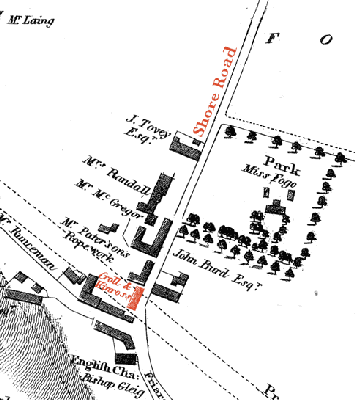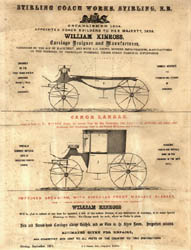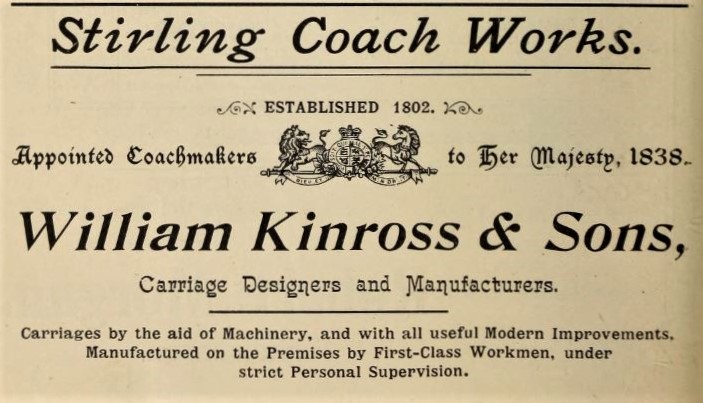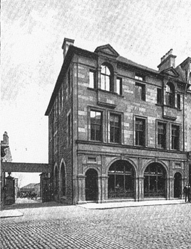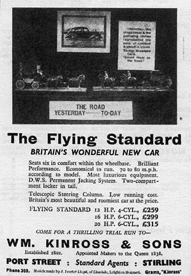| 1825 |
Henry Kinross was
present at the preliminary meeting of the Stirling School
of Arts and Mechanics Institute, being one of the founders. |
| 1830s |
The sons of Mr
Croall, after learning their trade, were not satisfied
with Stirling, and moved to Edinburgh. They founded a
successful coaching and ultimately bus-building business
there. |
| 1831 |
The 1845
Statistical Account of Stirling, states that in a
“carefully prepared offical report, for the information of the Government,
respecting the town and suburbs of Stirling”, that the 1831 turnover of
“coachmakers and ropemakers” amounted to £6,000-0-0.
Woollen manufacture has more than doubled, that of cotton has fallen off and
coachbuilding has much increased. There are about 100 employed in
coachbuilding working 10 hours a day. |
| 1832 |
A cholera epidemic strikes
Stirling and the rich start to move out from the Old Town to the suburbs to escape
infection. |
| 1837 |
The Croall & Kinross Company was formerly dissolved
by December 1837; the works now passed to Henry Kinross.
“The Company carrying on business as COACH-MAKERS, at the SHORE ROAD
of STIRLING, under the Firm of CROALL and KINROSS was DISSOLVED, on the 20th
day of September last, by mutual consent.
Signed by HENRY KINROSS and WILLIAM CROALL.
Witnessed by Archibald Sinclair and John Kinross, Stirling, 18th November, 1837.
Signed by JOHN CROALL.
Witnessed by Thomas Wilson and George Thomson, Edinburgh, 29th November, 1837.
In reference to the above, HENRY KINROSS, now sole partner of the establishment
above-mentioned, takes this opportunity of returning thanks to his Friends and the
Public for their very liberal support hitherto; and he begs at the same to assure
them, that he will use his every endevour to merit further continued support.
Stirling, 30th November, 1837.”
Front page of the Stirling Observer, 14th December 1837. |
| 1838 |
Henry was “appointed
coachmaker for Scotland to Queen Victoria”. The
Royal Warrant, under the hand and seal of Lord Albermarle, Master of
the Horse, was conveyed in letters by Lord Dalmeny to Henry Kinross
in 1838. He was the leading coachmaker in Scotland at the time,
being the only coachbuilder to be so honoured. |
| 1838 |
William Kinross, foreman, was presented with a silver
snuff-box by the workers as a “mark of respect.” “The
evening was spent in a very agreeable manner, several good speeches were delivered,
and some exellent songs were sung, and the party seperated highly gratified with
each other.” |
| 1840s |
Queen Victoria ordered a
Dog Cart
for the Balmoral estate with space underneath the seat for her Skye terriers Gay Girl, Spot and Wat. |
| 1842 |
“Queen Victoria and Prince Albert
visited Stirling on 13th September 1842.
On reaching the bridge at Stirling, the horses of the royal
coach were changed, and the entourage was joined by several
hundred men belonging to the local militia to escort Her
Majesty through the town. At this point too, Henry
Kinross, who was coachbuilder to the Queen, produced a huge
timber platform on wheels, which was capable of carrying 50
persons to join the escort. The Royal group was not
scheduled to visit his workshop, so Mr. Kinross, always a
razor-sharp entrepreneur, took the opportunity to pay his
compliments to his most valued customers.” |
| 1845 |
Mr. Henry Kinross, Coachmaker, Shore Road, is
listed on 2nd January in the Stirling Observer as one of the
High Constables of the Burgh of Stirling. “To serve as
a matter of reference to the Public, should anything be wanted in the
neighbourhood.” |
| 1845 |
Henry's nephew, William Kinross, took over the
carriageworks, when Henry died at Viewfield Street, aged 68, on
13th December 1845, forming William Kinross & Sons Ltd. |
| 1846 |
“Dissolution of Co-Partnery, Stirling
13th May 1846.
The business carried on by the Subscribers as Coach Builders in Stirling,
under the Firm of WILLIAM KINROSS & COMPANY, was this day DISSOLVED by
mutual consent. The Subscribers, WILLIAM KINROSS and JOHN KINROSS,
will carry on Business in the same Premesis, under the Firm of WILLIAM
KINROSS & COMPANY ; and the Subscriber; HENRY KINROSS, will conduct
business in his own name, and on his own account, on Premesis in the
course of erection in the Neighbourhood of the present Works.
All debts due to and by the late Firm will be paid to and by the
Subscriber, WILLIAM KINROSS.
Signed by WILLIAM KINROSS, JOHN KINROSS and HENRY KINROSS.
Witnessed by James Chrystal, June and William Ewing.”
Front page of the Stirling Observer, 4th June 1846. |
| 1847 |
On the 15th December William's wife, Janet Buchanan,
was killed by a runaway farm cart, but she just managed to put their two year old
son James to safety on the tailboard. |
| 1848 |
On 28th March the inventory of the late Henry
Kinross, Coachbuilder in Stirling included:
Balance on the price due by messrs. William Kinross & Company, Coachbuilders
in Stirling and William Kinross and John Kinross individual partners there:
of to the deceased for the book debts and stock in trade and good will of
the business of Coachwright carried on by him in Stirling £600.-.-.
Interest thereon from 11th November 1843 to 13th December 1845
£2.11.-. |
| 1848 |
The Scottish
Central Railway reached Stirling and the coachbuilders
became a major supplier of railway carriages. The
carriageworks were linked to the railway with their own
railway track. |
| 1850 |
On 21st March the Stirling
Observer reported: “a meeting of the Inhabitents of Stirling
on Tuesday 19th March formed a committee to support the
Great Exhibition.” This was attended by “William
Kinross Esq., Coach-builder, Stirling.” |
| 1851 |
On 31st March 1851,
the census records William Kinross as a widower, aged 40
living at Shore Road, Stirling with his sons, George,
aged 8 and James aged 5. William is described as a
coachbuilder of the firm William Kinross & Co.,
employing 70 men. |
| 1851 |
A disastrous fire
on 8th April destroyed the whole workshops, tools and stock in a few
hours, and the firm had to make a new beginning. |
| 1851 |
In 1851 the firm
secured a silver medal for the most improved street
omnibus design at the Great Exhibition at Crystal Palace.
This exhibit attracted much attention and brought many orders. |
| 1851 |
On 4th November William remarried to Ann, daughter
of William Marshall a Cumbernauld famer. They had 4 sons. |
| 1852 |
“From the departure of the last of his brothers for
Melbourne in 1852, William carried on the business alone”, ref.
“The Stirling Observer”, 27th May 1908. |
| 1853 |
“Dissolution of Co-Partnery, Stirling
13th September 1853.
The CO-PARTNERY carried on by the SUBSCRIBERS in Stirling under the Firm
of WILLIAM KINROSS and COMPANY, Coachbuilders there, has been DISSOLVED
this day by mutual consent.
The Business of COACHBUILDING will now be carried on by WILLIAM KINROSS,
who is authorised to uplift and pay the Debts due to and by the late
Company.
Signed by WILLIAM KINROSS and JOHN KINROSS.
Witnessed by William Cathcart and Robert Dodds.”
Front page of the Stirling Observer, 22nd September 1853. |
| 1850s |
William Kinross
received orders from the Duchess of Bedford, the Earl of
Derby, the Marquis of Londonderry and Viscount Shannon
and others, including many Scottish settlers abroad. |
| 1857 |
From 1857 to 1861, 90% of the carriages
were being made to order, for export to India. |
| 1865 |
The coach building
business prospered, so William moved the works from the head of the
Shore Road causeway to the larger
Port Street works in 1865. These premises had previously been
used as a brewery and a woollen mill, but were converted into spacious
workshops. |
| 1903 |
Robert
Taylor registered Stirling's “first motor vehicle
for public use” on 28th December. MS24
was built by the Motor Manufacturing Company of Coventry and had
a dark blue tonneau body with a yellow stripe picked out in
green. |
|
| 1908 |
The Stirling Observer reports on 27th May that
“the rivalry of the motor car has interfered considerably with the making
of new carriages, and the output of these is not as great as it was, but there
is a fairly good amount of work going on, and the firm continues to maintain
its high standard of reputation, whilst it has a band of loyal workmen, several
of whom have been in its employment for very many years.” |
| 1910 |
“The firm of William Kinross & Sons, coachbuilders, Stirling,
of which Mr. George Kinross and Mr. James Kinross were the sole partners, has been dissolved
as at Dec. 31st, 1909, of mutual consent by the retiral of Mr. George Kinross.
Mr. James Kinross will continue the business on his own account under the same name,
and will discharge the liabilities.” |
| 1911 |
James Kinross' son, David Morton Kinross (1881-1910) & Bailey
Scott Murphy, architects, worked on the motor garage and dwelling house for Messrs Kinross & Sons. |
| 1919 |
George Kinross died, aged 76, at his house at
4 Victoria Square, Stirling on 14th January 1919.
“He had had a nasty fall from slipping on the pavement 10 days
before, and evidently the shock to his system was too much for him.” |
